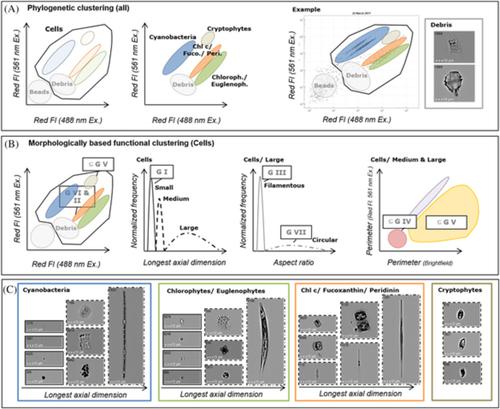当前位置:
X-MOL 学术
›
Cytom. Part A
›
论文详情
Our official English website, www.x-mol.net, welcomes your feedback! (Note: you will need to create a separate account there.)
Imaging Flow Cytometry for Phylogenetic and MorphologicallyBased Functional Group Clustering of a Natural Phytoplankton Community over 1 Year in an Urban Pond.
Cytometry Part A ( IF 3.7 ) Pub Date : 2020-05-30 , DOI: 10.1002/cyto.a.24044 Susanne Dunker 1, 2
Cytometry Part A ( IF 3.7 ) Pub Date : 2020-05-30 , DOI: 10.1002/cyto.a.24044 Susanne Dunker 1, 2
Affiliation

|
Ponds are an insufficiently studied research object but represent a biodiversity hotspot and have a high value for ecosystem services like recreation, water retention, or angling. Especially urban ponds create a direct contact for citizens experiencing nature. But on the other side, these systems also suffer from several pressures caused by humans, for example, high nutrient and salt influxes or high temperatures. Phytoplankton organisms are a crucial part of ponds ecosystem and an understanding of community composition is crucial especially when eutrophication and high temperatures lead to dominance of unpleasant toxic cyanobacteria. With traditional microscopic methods for phytoplankton analysis, monitoring is not feasible with high spatial resolution and frequency. Therefore, a new approach of imaging flow cytometry to classify phytoplankton species in either taxonomic or morphologically based functional groups (MBFGs) is suggested. In this study, both classifications could be successfully applied to a natural phytoplankton community in an urban pond in Leipzig with minor modifications. Both classifications in combination provide a good mechanistic understanding of phytoplankton community dynamics. In addition, a great advantage of the measurements is the archivability of microscopic images allowing a comprehensive respective data analysis. Two examples of detailed trait and image analysis are demonstrated to investigate single‐cell traits for cyanobacteria and chlorophytes/euglenophytes and to follow the fate of a cyanobacterial bloom affected by a fungal infection. © 2020 The Author. Cytometry Part A published by Wiley Periodicals, Inc. on behalf of International Society for Advancement of Cytometry.
中文翻译:

城市池塘中天然浮游植物群落超过 1 年的系统发育和基于形态的功能群聚类的成像流式细胞术。
池塘是一个研究不足的研究对象,但代表了一个生物多样性热点,对娱乐、保水或钓鱼等生态系统服务具有很高的价值。特别是城市池塘为市民体验自然创造了直接联系。但另一方面,这些系统也受到人类造成的多种压力,例如高营养和盐分流入或高温。浮游植物生物是池塘生态系统的重要组成部分,了解群落组成至关重要,尤其是当富营养化和高温导致令人不快的有毒蓝藻占主导地位时。对于浮游植物分析的传统微观方法,以高空间分辨率和频率进行监测是不可行的。因此,提出了一种新的成像流式细胞术方法,用于在分类学或基于形态学的功能组 (MBFG) 中对浮游植物物种进行分类。在这项研究中,两种分类都可以成功应用于莱比锡城市池塘中的天然浮游植物群落,只需稍作修改。两种分类的结合提供了对浮游植物群落动态的良好机械理解。此外,测量的一大优势是显微图像的可存档性,允许进行全面的相应数据分析。展示了详细性状和图像分析的两个示例,以研究蓝藻和叶绿体/裸藻的单细胞性状,并跟踪受真菌感染影响的蓝藻水华的命运。© 2020 作者。两种分类都可以成功应用于莱比锡城市池塘中的天然浮游植物群落,只需稍作修改。两种分类的结合提供了对浮游植物群落动态的良好机械理解。此外,测量的一大优势是显微图像的可存档性,允许进行全面的相应数据分析。展示了详细性状和图像分析的两个示例,以研究蓝藻和叶绿体/裸藻的单细胞性状,并跟踪受真菌感染影响的蓝藻水华的命运。© 2020 作者。两种分类都可以成功应用于莱比锡城市池塘中的天然浮游植物群落,只需稍作修改。两种分类的结合提供了对浮游植物群落动态的良好机械理解。此外,测量的一大优势是显微图像的可存档性,允许进行全面的相应数据分析。展示了详细性状和图像分析的两个示例,以研究蓝藻和叶绿体/裸藻的单细胞性状,并跟踪受真菌感染影响的蓝藻水华的命运。© 2020 作者。两种分类的结合提供了对浮游植物群落动态的良好机械理解。此外,测量的一大优势是显微图像的可存档性,允许进行全面的相应数据分析。展示了详细性状和图像分析的两个示例,以研究蓝藻和叶绿体/裸藻的单细胞性状,并跟踪受真菌感染影响的蓝藻水华的命运。© 2020 作者。两种分类的结合提供了对浮游植物群落动态的良好机械理解。此外,测量的一大优势是显微图像的可存档性,允许进行全面的相应数据分析。展示了详细性状和图像分析的两个示例,以研究蓝藻和叶绿体/裸藻的单细胞性状,并跟踪受真菌感染影响的蓝藻水华的命运。© 2020 作者。展示了详细性状和图像分析的两个示例,以研究蓝藻和叶绿体/裸藻的单细胞性状,并跟踪受真菌感染影响的蓝藻水华的命运。© 2020 作者。展示了详细性状和图像分析的两个示例,以研究蓝藻和叶绿体/裸藻的单细胞性状,并跟踪受真菌感染影响的蓝藻水华的命运。© 2020 作者。Cytometry Part A由 Wiley Periodicals, Inc. 代表 International Society for Advancement of Cytometry 出版。
更新日期:2020-07-22
中文翻译:

城市池塘中天然浮游植物群落超过 1 年的系统发育和基于形态的功能群聚类的成像流式细胞术。
池塘是一个研究不足的研究对象,但代表了一个生物多样性热点,对娱乐、保水或钓鱼等生态系统服务具有很高的价值。特别是城市池塘为市民体验自然创造了直接联系。但另一方面,这些系统也受到人类造成的多种压力,例如高营养和盐分流入或高温。浮游植物生物是池塘生态系统的重要组成部分,了解群落组成至关重要,尤其是当富营养化和高温导致令人不快的有毒蓝藻占主导地位时。对于浮游植物分析的传统微观方法,以高空间分辨率和频率进行监测是不可行的。因此,提出了一种新的成像流式细胞术方法,用于在分类学或基于形态学的功能组 (MBFG) 中对浮游植物物种进行分类。在这项研究中,两种分类都可以成功应用于莱比锡城市池塘中的天然浮游植物群落,只需稍作修改。两种分类的结合提供了对浮游植物群落动态的良好机械理解。此外,测量的一大优势是显微图像的可存档性,允许进行全面的相应数据分析。展示了详细性状和图像分析的两个示例,以研究蓝藻和叶绿体/裸藻的单细胞性状,并跟踪受真菌感染影响的蓝藻水华的命运。© 2020 作者。两种分类都可以成功应用于莱比锡城市池塘中的天然浮游植物群落,只需稍作修改。两种分类的结合提供了对浮游植物群落动态的良好机械理解。此外,测量的一大优势是显微图像的可存档性,允许进行全面的相应数据分析。展示了详细性状和图像分析的两个示例,以研究蓝藻和叶绿体/裸藻的单细胞性状,并跟踪受真菌感染影响的蓝藻水华的命运。© 2020 作者。两种分类都可以成功应用于莱比锡城市池塘中的天然浮游植物群落,只需稍作修改。两种分类的结合提供了对浮游植物群落动态的良好机械理解。此外,测量的一大优势是显微图像的可存档性,允许进行全面的相应数据分析。展示了详细性状和图像分析的两个示例,以研究蓝藻和叶绿体/裸藻的单细胞性状,并跟踪受真菌感染影响的蓝藻水华的命运。© 2020 作者。两种分类的结合提供了对浮游植物群落动态的良好机械理解。此外,测量的一大优势是显微图像的可存档性,允许进行全面的相应数据分析。展示了详细性状和图像分析的两个示例,以研究蓝藻和叶绿体/裸藻的单细胞性状,并跟踪受真菌感染影响的蓝藻水华的命运。© 2020 作者。两种分类的结合提供了对浮游植物群落动态的良好机械理解。此外,测量的一大优势是显微图像的可存档性,允许进行全面的相应数据分析。展示了详细性状和图像分析的两个示例,以研究蓝藻和叶绿体/裸藻的单细胞性状,并跟踪受真菌感染影响的蓝藻水华的命运。© 2020 作者。展示了详细性状和图像分析的两个示例,以研究蓝藻和叶绿体/裸藻的单细胞性状,并跟踪受真菌感染影响的蓝藻水华的命运。© 2020 作者。展示了详细性状和图像分析的两个示例,以研究蓝藻和叶绿体/裸藻的单细胞性状,并跟踪受真菌感染影响的蓝藻水华的命运。© 2020 作者。Cytometry Part A由 Wiley Periodicals, Inc. 代表 International Society for Advancement of Cytometry 出版。



























 京公网安备 11010802027423号
京公网安备 11010802027423号